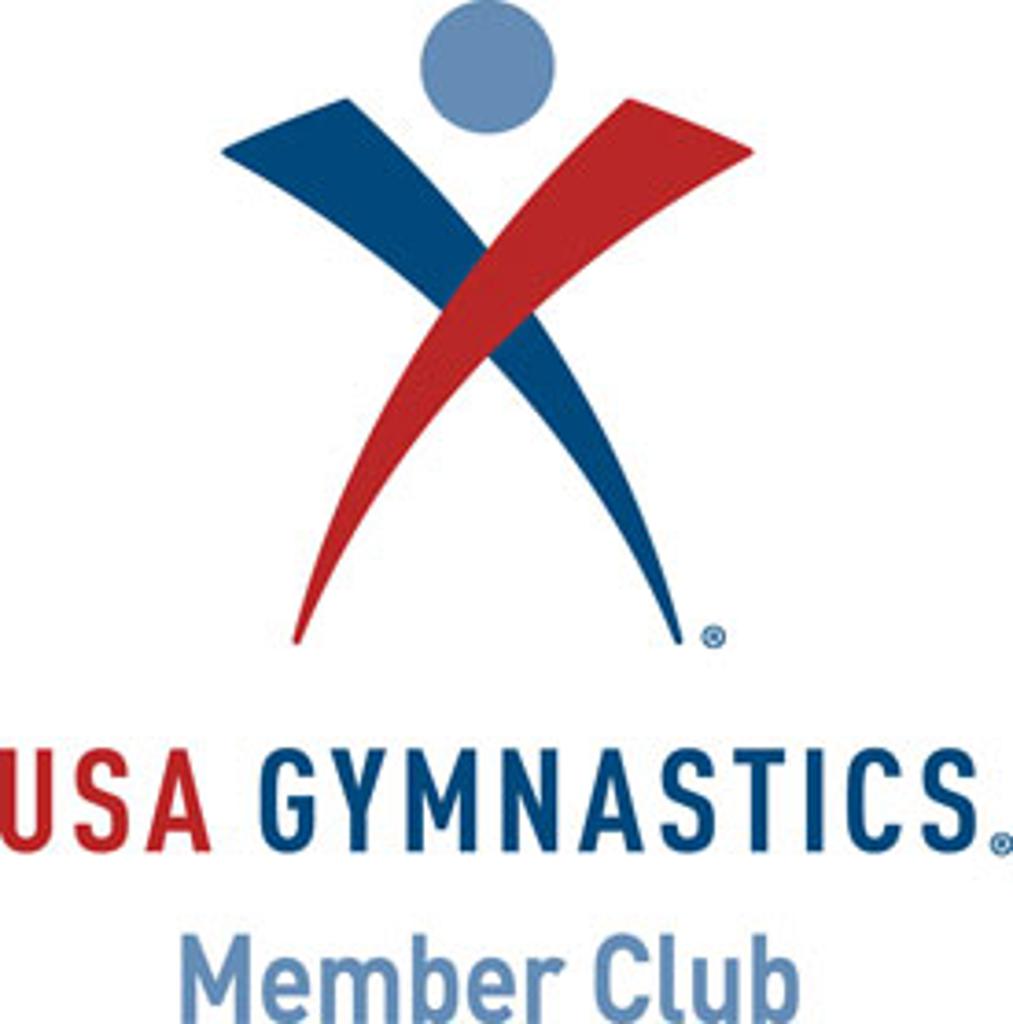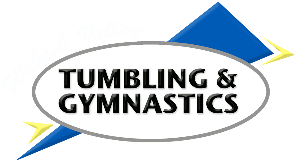
USA Gymnastics Junior Olympic Team
USA Tumbling & Trampoline Team
The gymnastics discipline of trampoline and tumbling, often referred to as T&T, includes three events. Trampoline, synchronized trampoline, double mini-trampoline, and power tumbling can be exciting at any level. Bouncing high, learning body control and developing spatial awareness are all adventures of the sport. One of the best parts of the program is it is a sport that both girls and boys can participate in.
Trampoline– Although even in the early years of trampolining, notable American and international athletes performed many of the difficult skills and combinations of skills that are seen today, modern trampoline competitions are quite different than those of the early developmental years — due in part to advances in equipment design, changes in the rules and governance, and more systematic training of the athletes.
Double Mini Trampoline– Double mini is a relatively new sport that combines the horizontal run of tumbling with the vertical rebound of the trampoline. After a short run, the athlete jumps onto a small two-level trampoline to perform a rebounding trick immediately followed by a dismount element onto a landing mat.
Power Tumbling– Power tumbling is performed on elevated spring runway, known as Rod Floor, that helps tumblers propel themselves with speed and height along with strength and skill while executing a series of acrobatic moves.
USA Gymnastics Junior Olympic (JO) Team Program
Gymnastics is a sport that requires balance, strength, flexibility, agility, coordination and endurance. The movements involved in gymnastics contribute to the development of the arms, legs, shoulders, back, chest and abdominal muscle groups. Alertness, precision, daring, self-confidence and self-discipline are mental traits that can also be developed through gymnastics. The women's events of vault, uneven bars, balance beam and floor exercise.
Floor exercise- event in which movements are performed on the floor in an area 12 metres (40 feet) square. The type of exercise required is a series of movements combining elements of flexibility, strength, jumps, holding of poses, and balance, as well as other maneuvers. The whole routine must be performed with rhythm and harmony, and the gymnast must move in different directions, using a major portion of the allotted area.
Vault- All gymnasts vault over a piece of apparatus called the table, a slightly-inclined with a padded springy cover. In 2001, the apparatus was changed, from a long cylindrical structure (similar to the pommel horse) to the current table. This is why it's sometimes still referred to as the vaulting horse. The relatively new vaulting table is designed to be safer for gymnasts because of its large push-off area (its length is almost 4 feet and its width about 3 feet).
Bars-The uneven bars or asymmetric bars is an artistic gymnastics apparatus. It is made of a steel frame. The bars are made of fiberglass with wood coating, or less commonly wood. The apparatus and event are often referred to simply as "bars". The bars are placed at different heights and widths, allowing the gymnast to transition from bar to bar.
Beam-The balance beam is a cube / rectangular object an artistic gymnastics apparatus, as well as the event performed using the apparatus. Both the apparatus and the event are sometimes simply referred to as "beam". The English abbreviation for the event in gymnastics scoring is BB. The beam is a small, thin beam which is typically raised from the floor on a leg or stand at both ends. The balance beam is only performed by female gymnasts. Beams are usually made of leather like material.
The Xcel Program is designed to offer a broad-based, affordable competitive experience outside the traditional JO program to attract and retain a diverse group of athletes.
Xcel is a great program for gymnasts that:
- are at a variety of levels, abilities, ages and commitment levels and want to enjoy all the benefits that gymnastics has to offer while having more flexibility than the JO program;
- have a passion for gymnastics and want to stay involved in the sport for the long term, while not striving for the goal of being a level 10 or elite gymnast;
- cannot be in the gym the number of hours that the JO program requires due to other activities or sports but still want to participate in gymnastics competitions;
- have fears of skills that the JO and compulsory programs require.
 Both recreational and competitive gymnastics programs promote strength, flexibility, endurance, confidence, fitness and fun. While recreational (non-competitive) programs are fitting for anyone, competitive programs usually require an invitation to join after being evaluated by a qualified coach.
Both recreational and competitive gymnastics programs promote strength, flexibility, endurance, confidence, fitness and fun. While recreational (non-competitive) programs are fitting for anyone, competitive programs usually require an invitation to join after being evaluated by a qualified coach.
What Do Coaches Look For When Inviting Kids To Team?
-
Physical Strength – Can the child easily perform strength exercises such as pull-ups, leg lifts, sprinting, push-ups, sit-ups, and hollow body holds?
-
Flexibility – Is the child’s body flexible enough to handle some of the requirements of gymnastics? Can his/her flexibility be improved over time?
-
Basic Skills – How are the child’s gymnastics/tumbling fundamentals? Has the child spent enough time in a class or pre-team program to master the basics? Can the child perform the basics properly? Does the child know proper gymnastics terminology?
-
Motivation – Does the child want to learn and succeed, or is she content right where she is?
-
Coachability – Does the child listen to corrections and try to apply them? Is the child willing to take a few steps back to fix old skills before learning new skills?
-
Mental Toughness – How sensitive is the child? Does he or she respond well to criticism? Would the child be able to perform in front of a judge and receive a performance-based score with no more than a healthy amount of anxiety?
- Sportsmanship – Would this child fit cohesivly with existing team members? Would he or she encourage the other athletes? Would this child accept both success and defeat respectfully and graciously?
Do Team Athletes Receive Better Training?
No. Team athletes do not receive better training than class athletes , but the majority of the time, they do receive MORE training. Most team athletes are required to train a minimum of 4 hours a week, while class students often only come 1 or 2 hours a week. The extra training time allows team coaches to focus on extra conditioning and the smallest of details in every skill.
Do Team Athletes Learn Bigger, Better Skills Than Recreational Class Gymnasts?
No. Both recreational and competitive athletes follow the same curriculum and skill progression set forth by USA Gymnastics. Team gymnasts who have learned impressively difficult skills have done so after committing themselves to a team program for several years and putting in countless hours of training time.
All class students have the opportunity to learn the same skills as athletes on our teams, but must do so while following the proper skill progression. With any athletes , safety is always the number one priority. Class coaches take into consideration a child’s strength, flexibility, and mental readiness before beginning to teach a new, more difficult skill.
Do Team Athletes Progress Through The Levels Faster?
No. In fact, many team athletes who are well-trained, strong, and appear to have all of their skills will often repeat a level in order to improve their fundamentals before moving on to the next level. USA Gymnastics/Tumbling & Trampoline provides a set of requirements for each competitive level. Many athletes compete successfully for an entire season while missing just one small requirement. It is very common to see a competitive athlete repeat more than one level in order to meet every requirement and achieve a great amount of success.
Class students have a bit more flexibility in this matter; class coaches will often forgive a certain skill or two a child may struggle with and promote her to the next level in order to maximize her potential in a smaller amount of time.
What Is Required of Team Athletes?
-
Commitment – Gymnastics/Tumbling & Trampoline are sports that require a team member’s presence for every minute of scheduled training time. Team members are expected to attend all practices, competitions, fundraisers, and other team events. Team members are expected to arrive on time and prepared to train (hair up, gymnastics attire on, water bottle in hand, etc.). While being on a competitive team is fun, it is not a social hour and is not something you show up for when you have nothing else to do… If a child is not willing to commit to the requirements of their team, it is best to consider other options, such as the class program, camps, or private lessons.
-
Proper Health & Nutrition – An athlete cannot train or perform to the best of their abilities without proper nutrition. All team athletes are expected to eat a well-balanced diet and stay hydrated in order to keep their bodies in the best physical shape possible.
- Attitude – Team athletes are expected to have a good attitude towards themselves, their teammates and their coaches. They need to accept criticism in order to improve, and they need to encourage their teammates to be the best they can be.
-
Family Commitment – Athletes requires a strong family commitment, in the form of transportation, financial assistance, nutritional advice, fundraising, support at competitions, and mental support throughout training. Busy families are encouraged to share contact info to arrange carpools, child-care, etc. to ensure their gymnast is able to be where he or she needs to be at the right time.
-
Finances – It’s the part no one wants to think about, but we want to be honest with you. Being on a competive team can be expensive. On top of monthly tuition, you need to consider the price of uniforms, choreographers, competition entry fees, coaches fees, and travel fees.
-
Fundraising – Our booster club will arrange fundraising events to help ease the financial burden of being on a team. These events may take the form of hosting a meet, selling candy bars, canning outside a store, holding a raffle, etc.
Many team athletes have already decided that competition will be their life. They want to train through elementary and junior high school. They want to compete in high school and college. Because of their years of commitment and dedication, and more than anything else, the number of hours they spend training, they generally tend to rise to higher levels and learn harder skills.
Many class athletes are not as committed, and maybe only want to take practice once or twice a week for a year or two. They may want to play other sports, dance, act, and sing, and travel… That’s OK! Gymnastics can be fun for anyone, regardless of their natural talent or level of commitment. No matter what level, our class and team programs are designed to provide each and every child with a unique experience that is both fun and rewarding!

